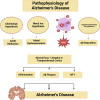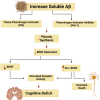Unlocking Alzheimer's Disease: The Role of BDNF Signaling in Neuropathology and Treatment
- PMID: 40380033
- PMCID: PMC12084274
- DOI: 10.1007/s12017-025-08857-x
Unlocking Alzheimer's Disease: The Role of BDNF Signaling in Neuropathology and Treatment
Abstract
Alzheimer's disease (AD) remains one of the most debilitating neurodegenerative disorders, with its pathological hallmark being progressive cognitive decline and memory loss. Recent research has illuminated the crucial role of the brain-derived neurotrophic factor (BDNF) in the central nervous system (CNS), highlighting its impact on neurogenesis, synaptic plasticity, and neuronal survival. Dysregulation of the BDNF signaling axis, particularly the imbalance between its precursor form and mature BDNF, is strongly implicated in the pathophysiology of AD. This review explores the molecular mechanisms through which BDNF modulates AD neuropathology and presents novel therapeutic strategies to activate BDNF signaling. We focus on the potential of BDNF activators, such as TrkB agonists and mimetic molecules, to restore synaptic function and ameliorate cognitive deficits in AD. Furthermore, we examine the challenges in translating these findings into clinical practice, including issues with blood-brain barrier penetration and the need for precise receptor targeting. The review emphasizes the therapeutic potential of repurposed drugs, including statins and metformin, in enhancing BDNF signaling and offers new insights into the future of AD treatment. Ultimately, this work provides a compelling argument for BDNF-based therapies as a promising avenue for mitigating the cognitive decline associated with Alzheimer's disease, signaling a hopeful direction for future research and clinical trials.
Keywords: Alzheimer’s disease; Brain-derived neurotrophic factor; Cholinergic neurons; Neurodegenerative diseases; Statins.
© 2025. The Author(s).
Conflict of interest statement
Declarations. Conflict of interest: The authors declare no competing interests. Ethical Approval: Not applicable. Consent to Participate: Not applicable. Consent for Publication: Not applicable.
Figures




Similar articles
-
Brain-Derived Neurotrophic Factor in Alzheimer's Disease: Risk, Mechanisms, and Therapy.Mol Neurobiol. 2015 Dec;52(3):1477-1493. doi: 10.1007/s12035-014-8958-4. Epub 2014 Oct 30. Mol Neurobiol. 2015. PMID: 25354497
-
Brain-Derived Neurotrophic Factor Signaling in the Pathophysiology of Alzheimer's Disease: Beneficial Effects of Flavonoids for Neuroprotection.Int J Mol Sci. 2021 May 27;22(11):5719. doi: 10.3390/ijms22115719. Int J Mol Sci. 2021. PMID: 34071978 Free PMC article. Review.
-
7,8-dihydroxyflavone, a small-molecule TrkB agonist, reverses memory deficits and BACE1 elevation in a mouse model of Alzheimer's disease.Neuropsychopharmacology. 2012 Jan;37(2):434-44. doi: 10.1038/npp.2011.191. Epub 2011 Sep 7. Neuropsychopharmacology. 2012. PMID: 21900882 Free PMC article.
-
Donepezil improves the cognitive impairment in a tree shrew model of Alzheimer's disease induced by amyloid-β1-40 via activating the BDNF/TrkB signal pathway.Metab Brain Dis. 2018 Dec;33(6):1961-1974. doi: 10.1007/s11011-018-0303-6. Epub 2018 Aug 13. Metab Brain Dis. 2018. PMID: 30105614
-
The Role of Brain-Derived Neurotrophic Factor as an Essential Mediator in Neuronal Functions and the Therapeutic Potential of Its Mimetics for Neuroprotection in Neurologic and Psychiatric Disorders.Molecules. 2025 Feb 12;30(4):848. doi: 10.3390/molecules30040848. Molecules. 2025. PMID: 40005159 Free PMC article. Review.
Cited by
-
Decreased brain-derived neurotrophic factor expression in chronic kidney disease: integrated clinical and experimental evidence.Front Mol Biosci. 2025 Jul 28;12:1627534. doi: 10.3389/fmolb.2025.1627534. eCollection 2025. Front Mol Biosci. 2025. PMID: 40791659 Free PMC article.
References
-
- Ali, N. H., Al-Kuraishy, H. M., Al-Gareeb, A. I., Alnaaim, S. A., Alexiou, A., Papadakis, M., Saad, H. M., & Batiha, G.E.-S. (2024a). The probable role of tissue plasminogen activator/neuroserpin axis in Alzheimer’s disease: A new perspective. Acta Neurologica Belgica,124(2), 377–388. - PMC - PubMed
-
- Ali, N. H., Al-Kuraishy, H. M., Al-Gareeb, A. I., Alnaaim, S. A., Saad, H. M., & Batiha, G.E.-S. (2024b). The molecular pathway of p75 neurotrophin receptor (p75NTR) in Parkinson’s disease: The way of new inroads. Molecular Neurobiology,61(5), 2469–2480. - PubMed
Publication types
MeSH terms
Substances
LinkOut - more resources
Full Text Sources
Medical

